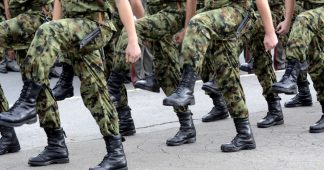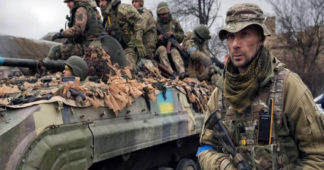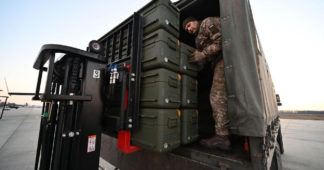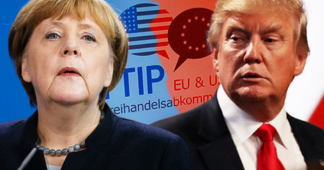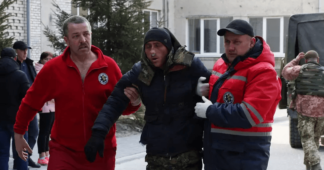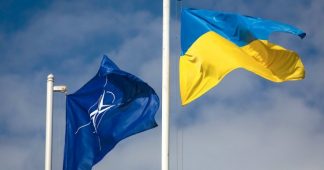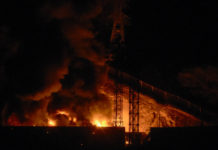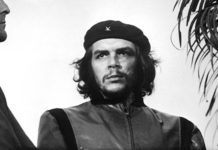As terrible as it is for the Ukrainian people, the Ukrainian war is only a side issue in a much larger story.
Wolfgang Streeck is the Emeritus Director of the Max Planck Institute for the Study of Societies in Cologne, Germany
Cross-posted from El Salto
Translation by BRAVE NEW EUROPE
In 2021, the year before its invasion of Ukraine, Russia spent $65.9 billion (constant 2020) on its armed forces, equivalent to 4.1 per cent of its GDP. Germany, with a population just over half that of Russia, spent $56 billion, or 1.3 per cent of its GDP. The respective figures for the UK, France and Italy were 68.4 billion (2.2 per 100 per cent of GDP), 56.6 billion (1.9 per 100 per cent of GDP) and 32 billion (1.5 per 100 per cent of GDP). Together, the four largest EU member states spent slightly more than three times as much on defence as Russia. US military spending, equivalent to 38 per cent of the world total, exceeded Russian spending by a factor of twelve and when combined with that of the four large European NATO countries by a factor of fifteen (SIPRI Fact Sheets data, April 2022).
Figures on military spending are less reliable than those on, for example, average temperatures. But even if the data provided by SIPRI, the most reputable research institute in the field, are only half-valid, the Russian invasion raises the question of why an obviously lesser power would have risked a confrontation with a much stronger bloc such as the US-led one. The fact that Russia attacked from a position of weakness is also borne out by the fact that, in the opinion of military experts, its invasion force, estimated at 190,000 troops in February 2022, was too small to achieve its presumed objective, the conquest of Ukraine, a country of 40 million people with a land mass almost twice that of Germany, the achievement of which would have required, according to the majority estimate, a doubling of the contingent employed. And although the Ukrainian defence budget in 2021 amounted to less than six billion dollars (or 3.2 per cent of the GDP of one of Europe’s poorest countries), this represented an impressive 142 per cent increase in Ukrainian military spending compared to 2012, by far the highest growth rate among the world’s top forty military spenders. It is a secret only to the so-called quality European media that this increase was due to extensive US military aid, aimed at achieving ‘interoperability’ of the Ukrainian army with the US military. According to NATO sources, interoperability was achieved in 2020, effectively making Ukraine a de facto, if not de jure, member of NATO.
Despite the fact that the Russian invasion took place from a position of spectacular military inferiority (albeit with public assurances lavishly provided by the United States and NATO, renewed almost weekly to this day, that they would never send troops to help the Ukrainians on the battlefield), from the first day of the war Germany was under insistent political and moral pressure from the United States to increase its military spending in order to meet, once and for all, NATO’s long-standing goal of having its member states spend 2 percent of their GDP on what it calls “defence”.
As early as the late 1990s, the United States had urged European NATO members to spend more on their armed forces, as the Americans themselves were beginning to do at the time. At the NATO summit in Prague in 2002, the 2 percent target was discussed for the first time in the context of 9/11, the emerging “War on Terror”, the impending invasion of Iraq, the expansion of the Alliance’s mandate to conduct operations outside its traditional area of engagement and the decision to extend NATO membership to Eastern European countries, starting with the “Visegrad States”, i.e. Poland, Hungary and the Czech Republic. This decision put an end to earlier discussions on the “common European home” (Gorbachev) or the “Partnership for Peace” (Bill Clinton), which included Russia, initiating a return to the Cold War border between Western and Eastern Europe, the latter now consisting essentially of Russia alone.
The 2 per cent target was formally adopted at the 2006 NATO summit in Riga. In 2008 Merkel and French President Sarkozy managed, at the last minute, to block a formal invitation to Ukraine and Georgia to join the Alliance, the third and final step in NATO’s expansion into Eastern Europe. In 2014, following the Maidan revolution that overthrew a pro-Russian Ukrainian president and Russia’s subsequent annexation of Crimea, the commitment to the 2 per cent target was renewed. Although formally the acceptance of this commitment affected all NATO members equally, in reality it was directed primarily at Germany, since it was the only country whose size, if it were to take on such an increase in military spending, would lead to a significant absolute increase in NATO’s military strength. The other two large European member states, France and the United Kingdom, had already been spending 2 or nearly 2 per cent of their GDP on defence for some time: respectively 2.49 and 2.10 in 2002; 2.48 and 1.90 in 2008; and 2.17 and 1.86 in 2014. Germany, by comparison, spent only 1.33 per cent in 2002, 1.21 per cent in 2008 and 1.15 per cent between 2014 and 2018, after which it began a moderate increase, reaching 1.34 per cent in 2021.
There appear to have been several reasons why the four successive Merkel governments formed between 2005 and 2021 have been unable or unwilling to devote 2 per cent of GDP annually to military spending. The existence of an overly finicky procurement bureaucracy and an alleged deep-seated pacifism of the German electorate stemming from Germany’s defeat in the two world wars are often cited. Since the start of the war in Ukraine, reports have circulated that Merkel believed Putin’s promises to respect what the West considers international law, which, while allowing the US and its ‘coalition of the willing’, including Ukraine, to invade Iraq, presumably prohibits Russia from invading Ukraine. Whether Putin ever made such promises is left to future historical research, but given his public warnings against Ukrainian and Georgian NATO membership, tirelessly repeated since 2002, this seems doubtful.
Three other factors may be more important in explaining this containment of German military spending: the first is that Germany does not have nuclear weapons, which absorb a good part of UK and French military spending, so German conventional forces can be roughly equal to those countries’ despite having a lower total defence budget; the second factor is that, unlike other countries, all German forces without exception are integrated into NATO, which means that any increase would primarily benefit the United States; and finally, that in relation to all this, post-World War II Germany so far lacks any military doctrine and does not even have a military staff to find out what its armed forces really need. Indeed, when German soul-searching after the invasion of Ukraine sought to find the reasons for the alleged neglect of the Bundeswehr by successive German governments over the past two decades, an investigative journalistic piece published in the Süddeutsche Zeitung showed that German military procurement policies had long oscillated indecisively between the territorial defence of Germany and Europe (“Landes- und Bündnisverteidigung”) and organised missions outside the traditional NATO area of intervention, such as Afghanistan and Mali, undertaken as a courtesy to the United States and France, which required very different equipment and which, moreover, turned out to be more expensive than expected.
However, prevailing German and international public opinion quickly embraced the assertion that Russia would not have invaded Ukraine if Germany had spent 2 per cent of its GDP on defence spending as dictated by NATO. It followed that Germany urgently needed to mend its ways, not least to prevent Russia from attacking other European countries as well, including Poland and the Baltic states, but also Finland and Sweden. The fact that Russia had not even been able to conquer Kiev, located just a few kilometres from the Russian border, since the beginning of the conflict has not figured at all in the prevailing “discourse”, which also paid no attention to the fact that if “Putin” was crazy enough to try to conquer Finland, he would probably also be crazy enough to use nuclear weapons if he felt in danger.
It is not entirely clear how this special fund will relate to the regular defence budget, in particular to the goal of spending 2 per cent of German GDP on defence. The plan seems to be that the fund will be spent over several years, each year topping up recurrent spending to the full 2 per cent, while recurrent spending gradually increases so that once the special fund is exhausted, it will have reached this percentage and remain fixed at this spending benchmark. In his 27 February speech, Scholz went so far as to promise that Germany would “invest year after year even more than 2 per cent of its GDP in defence”, an extravagant exaggeration that subsequently disappeared from government documents. Meanwhile, it was determined that around 40 billion euros would go to Germany’s air force, 19 billion to its navy and 17 billion to its army, while 21 billion would be spent on what is called ‘command and digitalisation capabilities’, a heading that includes everything from satellites to digital radios for troops.
Spending 100 billion euros is no easy task. The sum is roughly half of what Italy is to receive under the EU’s Next Generation Fund, which is officially to be spent over a seven-year period. The first item on this new shopping list is thirty-five Lockheed Martin F-35 multi-role stealth fighter-bombers, a favourite object of desire of current Green foreign minister Annalena Baerbock, who during coalition talks forced the SPD to make it a top priority for the new government. The F-35 is authorised by the US Air Force to carry US nuclear bombs under the so-called “nuclear sharing” agreement signed with Germany, something highly valued by the German military, although target selection is, of course, strictly reserved to the US high command. The aircraft, which will replace the Tornado fighter-bomber introduced in the 1980s, is the US’s main combat aircraft, which as of April 2022 operated 790 of them worldwide and plans to increase its fleet to 2,456 aircraft by 2040. An F-35 is said to cost 100 million euros, but that price is likely to rise significantly, perhaps reaching 150 million when delivery is verified in an estimated three to four years. It also seems certain that the Luftwaffe will receive around sixty CH47 Chinook transport helicopters, available in four to five years at the earliest and costing approximately 5 billion euros. Also on the shopping list is the purchase of forty Israeli Heron TP combat drones.
The coming years will see an all-out struggle between the arms industries of Europe and the United States, competing for a share of the German bonanza. France will see the special fund as another opportunity to pursue a self-directed industrial policy applicable to the European ‘defence’ industry and aimed at merging French and German producers so that the new conglomerates become global players strong enough to compete with their US counterparts – all of which will, of course, once again be in vain. To keep the French happy, Germany will also spend some of the fresh money on the new ECR (Electronic Combat Role) version of the Eurofighter and probably even more on the FCAS, the Future Combat Air System, a French sci-fi mirage, combining satellites, drones and fighter-bombers into an irresistible instrument of Franco-European global power projection. None of this will be used in the Ukrainian war, which will be over in one way or another by the time the new equipment is operational. This, however, is not mentioned to German public opinion, which tends to assume as a matter of course that the 100 billion in new military spending will contribute to ending the suffering of the Ukrainian people subjected to the brutalities of the Russian army. In fact, one sometimes gets the impression that this special fund for financing German defence spending functions as a smokescreen behind which the Scholz government hides a peculiar reluctance to deliver heavy weapons to Ukraine, This is taking place against the backdrop of intense pressure from the Ukrainian ambassador to Germany (who has become a moral authority in our country and accuses Germany almost daily on Twitter of a lack of moral fibre and a lack of “European values”), which is reenforced by mainstream German and international media and, needless to say, the CDU/CSU opposition.
The supply of arms to Ukraine is much more than a technical issue and has important strategic implications. One of them relates to the question of how and when a third country becomes a combatant, that is, when the ally of one side can be legitimately attacked, under international law, as an enemy by the other combatant side. There is, of course, a threshold, not easily defined, at which support from outside the battlefield becomes participation in the war conflict in question. German public consent-makers pretend that there is no such line, implying that Germany can hand over to Ukraine whatever it demands without legally becoming a Russian target. (Of course, the same sources say that what is called “Putin” does not give a damn about international law). That this is not entirely the case may be one reason why the Scholz government, though it dares not say so publicly, has been slower than other governments to commit to sending heavy weapons to Ukraine and, once committed, to actually deliver them. After all, of the major NATO powers involved, Germany is the closest to the theatre of war and to Russia. It also has no nuclear defences and its Ukraine-bound ground transport units of tanks and heavy artillery can easily be intercepted by “Putin” before they reach their destination.
While the German international law community remains silent on the issue and it is completely avoided by mainstream journalists, the Frankfurter Algemeine Zeitung, in a moment of truth on 18 May, could not avoid publishing a letter to the editor from one of Germany’s leading experts on international law, Jochen Abraham Frowein, former director of the Max Planck Institute. Frowein, a conservative if ever there was one, laconically observed that by supplying arms to Ukraine, Germany could become ‘a party to an armed conflict’ regardless of whether or not Russia violated Article 2 of the UN Charter, which prohibits wars of aggression, implying, in his view, that ‘German military forces, including their positions on German soil, could be attacked by Russia’. Referring to what the anti-Scholz camp saw as a morally negligent lack of resolve to come to the aid of an invaded country, Frowein concluded, “the Federal Government’s caution about being a party [to the war] is fully justified”.
Ukraine’s demands for military hardware are far from modest. An adviser to President Zelensky made it known in mid-June that to ‘win’ the war the country needed at least a thousand 155mm howitzers, three hundred multiple rocket launchers, five hundred tanks, two thousand armoured combat vehicles and a thousand drones. Compare this with the seven howitzers provided in cooperation with the Netherlands and the four rocket launchers Germany delivered to Ukraine two weeks later. The United States, which maintains military bases in eighty-five of the world’s two hundred countries (as opposed to the eight Russian bases present in countries adjacent to Russia), could of course have supplied Ukraine on its own with even the huge quantities of materiel it is requesting, having already single-handedly sustained the increase in Ukrainian military spending recorded since 2014. (Recently, the Biden administration got Congress to set aside another $40 billion in military aid to Ukraine this year alone). ) The fact, however, that efforts are being made to bring other countries – now numbering around forty, NATO and non-NATO, and including some very small ones such as Croatia – into the war effort as well is for political reasons aimed at demonstrating the unity of the ‘West’, now revived under US leadership. Moreover, as in the assassination of Julius Caesar, where each conspirator had to plunge his knife into his victim (“You too, Brutus, my son?”), this will serve to distribute responsibility so that no one can later deny involvement in the war effort and, if necessary, be safe from Russian counter-attacks. Large-scale arms deliveries, which turn a country into a quasi-combatant, might also prevent it from subsequently mediating between the warring parties, which, from the US perspective, would be especially welcome in the case of Germany and France.
Another strategic aspect of arms deliveries to Ukraine has to do with Ukraine’s war aims and the degree to which its allies can influence them. The more hardware Ukraine receives, the more ambitious its political goals can become. Under the influence of the far-right Ukrainian nationalist movement, the current Ukrainian government has moved away from the 2014 and 2015 Minsk Agreements and the agreement envisaged by the so-called ‘Normandy Format’, the contact group of the heads of state and government of Ukraine, Russia, Germany and France formed to end the war in the Donbas. (The United States did not participate in either negotiating process.) The Normandy agreement provided for Ukrainian neutrality, regional autonomy for Ukraine’s Russian-speaking provinces, in particular the Donbas, and future negotiations on the status of the Crimean peninsula.
Currently, Ukraine’s declared war aims include the expulsion of all Russian forces from the country, the unconditional return of Crimea, the return of the breakaway provinces under Kiev’s central authority and the country’s entry, if not into NATO, then at least into the EU. NATO and the EU have publicly pledged to leave it to the Ukrainian people themselves to decide their own goals, the timing of negotiations and the content of the settlement. To the applause of the Ukrainian government, the US and other Western countries, including the UK, have also indicated that for them the goal of the war is a ‘victory’ over Russia that ‘decisively weakens’ its military and economy, as well as Putin’s trial at the International Criminal Court in The Hague. (Scholz’s line on this is that Russia should not win the war and Ukraine should not lose it rather than that Ukraine should win it and Russia should lose it). ) In this context, Ukrainian access to advanced military equipment is important, as it affects whether Ukraine, fighting on its own without US and NATO forces fighting materially alongside it, can be able to withstand a war, potentially lasting several years, and do so with the possibility, however small, of ultimately winning it. To do so, the Ukrainian government would have to ask its citizens to accept massive losses of life and wealth for the sake of maximalist national objectives pursued in a war that, to all intents and purposes, amounts to a proxy war fought in the name of “the West” and aimed at eliminating Russia as an independent economic and political power.
By determining what and how much arms it supplies to Ukraine, its allies can be confident of exerting their influence over the objectives, duration and outcome of the war by conditioning the balance of forces of the contenders on the battlefield with respect to their respective objectives. For the US, arming Ukraine while the war drags on should ensure that the mood in the country does not shift in favour of a return to a less ambitious and “defeatist” Minsk-style agreement, which is not in the interests of either Germany or, indeed, France, especially as the risk of Russia pulling the emergency brake and using its nuclear force may increase over time. For Europe, a nuclear turn in the Ukrainian war would be a catastrophe, while the United States would not be affected much, if at all, by such a nuclear scenario. Germany, in particular, is surely less interested than the US in a protracted war fought with Western equipment made abundantly available to Ukraine. The slow delivery of weapons may be an attempt, albeit a feeble one, to get the Ukrainian government to consider a settlement before Putin is handed over by his country to stand trial at the International Criminal Court, provided that a deal like the one envisaged by the Normandy contact group can be reached. (Attempts to influence Ukrainian war aims by a country threatened by the risk of nuclear confrontation could be characterised by the slogan: “No annihilation without representation”). The situation may be similar in France and Italy, while the UK, further removed from the theatre of war, has as usual closed ranks with the US.
What is happening with the Zeitenwende? Enormous as it may seem, the special 100 billion military spending investment fund created by the German government merely reflects a long-standing trend in world politics after the ‘peace dividend’ dried up and George H. W. Bush’s New World Order unravelled during the 1990s. Global military spending, in constant 2020 dollars, began to decline in 1989 to reach a secular low ten years later, bringing it down to two-thirds of its 1988 level. Thereafter, and this is the real Zeitenwende, it rose steadily, reaching its 1988 level again in 2007, continuing to rise thereafter until 2010 and further after 2015 to reach a record level in 2020 and 2021, which put it one-third above the volume reached in 1988, the last year of the Cold War. The driving forces behind this increase were the United States and China. Between 1990 and 2001, US military spending fell by a quarter; then, in 2002, it began to rise rapidly, increasing by almost two-thirds between 2001 and 2010. By 2016, US military spending had fallen back to the 2004 level, only to rise again by 11.3 per cent between 2017 and 2021. In parallel, the US dismantled the US-Russian arms control architecture step by step. In 2002 it formally withdrew from the 1972 Anti-Ballistic Missile Treaty (ABM), which limited anti-ballistic missile defence systems; in 2009 it let the Strategic Arms Reduction Treaty (START I) expire; in 2000 it prevented START II, negotiated in 1993, from entering into force by withdrawing from the ABM; then refused to negotiate a possible START III treaty on warhead limitation; and in 2019 it again unilaterally withdrew from the Intermediate-Range Nuclear Forces (INF) Treaty in order to start building missile defence delivery systems in European countries such as Romania, Poland and the Czech Republic. Although this was supposedly to protect Europe from Iranian nuclear missiles, the US also cancelled in 2018 the nuclear non-proliferation agreement reached with Iran in 2015, negotiated together with major European powers.
Although the US exit from ABM, START and INF primarily affected Russia, in a supposedly double sense, China was and will increasingly be the second major player in the global build-up of means of destruction after the end of history. Until the late 1990s, Chinese military spending was almost negligible, amounting to no more than 8 per cent of US spending. Then it accelerated, growing faster year after year even than the US, which in turn was growing faster than ever. In 2005 it had risen to 10 per cent, five years later to 15 per cent, in 2015 it reached 29 per cent, and by 2021 it had reached 35 per cent. In 1998, a year before Yeltsin handed over the country to Putin in a sorry state, Russia’s military budget was 3.1 per cent of that of the US. Despite enormous efforts after 2004, when Russia considered that Putin’s European project of ‘an open Europe from Lisbon to Vladivostok’ would predictably fail, the relative size of Russian military spending increased to only 5.2 per cent of the US in 2010, doubling to 10.7 per cent in 2016 and falling back to 8.2 per cent in 2021. If ever there was a Thucydides moment, it might seem to lurk around the corner for the United States and China, as it perhaps lurked for Russia in 2021, as it watched the US power arm Ukraine.
As terrible as it is for the Ukrainian people, the Ukrainian war is but a side issue in a much larger story: that of the unfolding battle between a declining global hegemonic power and a rising one. An important function served by the current war is the consolidation of US control over its European allies, who are needed to support the US (Obama) power’s ‘pivot to Asia’ over what used to be the South China Sea and is now referred to by the loyal Western mediacracy as the Indo-Pacific. Europe’s task is to prevent Russia from taking advantage of the US turning its armed attention to other corners of the world and, if necessary, joining the US power in its Asian expedition (something the UK is already actively preparing for). There is no guarantee that there will not be a nuclear explosion along the way, especially in Western Europe. For the countries of this region, the most pressing question is whether they will dare to aspire over the next two or three decades to be anything more than an auxiliary to the United States in the twin tasks of controlling Russia and assisting it in its impending battle with China – a question that Scholz, Macron and company must address immediately before it is too late.
We remind our readers that publication of articles on our site does not mean that we agree with what is written. Our policy is to publish anything which we consider of interest, so as to assist our readers in forming their opinions. Sometimes we even publish articles with which we totally disagree, since we believe it is important for our readers to be informed on as wide a spectrum of views as possible.
